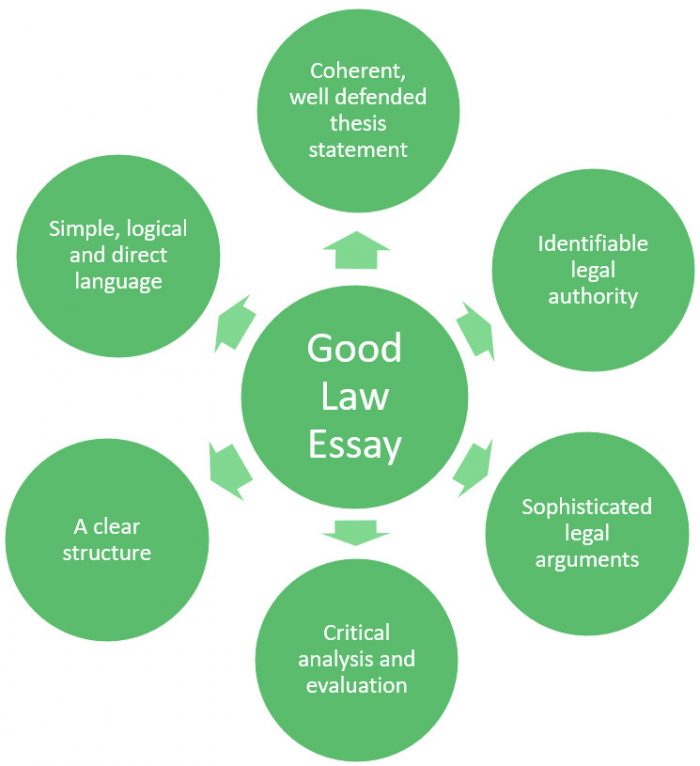
An excellent law essay should demonstrate detailed arguments and legal analysis, with a thesis statement that sums the argument up succinctly and concisely in two or three sentences. The aim should be that you are able to prove your conclusions, and importantly demonstrate that you are able to disprove competing views (the counterarguments). In general, you should first understand that a law essay will normally be focused on resolving a legal controversy, rather than dealing with application of the law to facts or problem resolution. This can be challenging for many students but following some key steps and principles will ensure that you can deliver an essay that has the following elements.

Plus, if you follow our tips and practical guidance you can be confident that your essay will deliver all of these pieces, in a way that ensures you demonstrate your ability to translate your knowledge of the law into a first-class assignment.
The first thing to ensure is that you fully recognise the elements that all good essays share irrespective of the subject.
Key components of a good essay
Whatever your subject or discipline, but crucial in a law essay are the following elements for an outstanding essay:
- Attention to detail and a focus on the question posed.
- In-depth understanding of the right legal frameworks and laws clearly defined and described in simple language.
- Logical structure and flow
- Well-defended and clearly expressed thesis statement.
- Ability to demonstrate wider contextual issues, such as policy, history and clearly identifiable area of law.
- Critical application to answering the question.
- A level of creativity and original flair in the response, based on clear, well-researched legal arguments, including lateral thinking about less obvious points of law.
- Accurate referencing and use of any quotations or case law.
- Concise writing, and an effective style.
So, the list above shows what to incorporate into your essay but there are also some clear areas you should avoid.
What To Avoid In Your Law Essay
Do not use casual or informal language.
Keeping it simple does not mean informality; your style should remain academic and not include slang, abbreviations or colloquialisms, unless they are direct, properly referenced quotes.
Keep the overall look of the work balanced and always use full sentences.
Avoid overly long or short paragraphs and resist the temptation to use bullet points in your law essay as this does not demonstrate clear analysis or evaluation.
Avoid Incorrect citations of legislation.
Each university has different rules regarding how these should be presented in your law essays, so ensure you know and understand your institution’s requirements.
Credit all sources.
If you do not have a source, any legal argument not only loses credibility but becomes meaningless. Of course, all sources should also be credible, relevant and checked. At the same time, do not pepper your essay with irrelevant sources, each case cited should be there for a valid reason, and clearly evaluated and analysed.
Steps for Creating the Perfect Law Essay
Deconstruct and understand the question
This does not mean choosing a side in the presented controversy, the important factor in a good law essay is to ensure that you propose a thesis, discuss, and then prove this, with effective use of legal argument and legal precedent. Other arguments are therefore a key element of your answer, as you need to be able to prove your arguments. Therefore, breaking down the question to understand the controversy under discussion, and then developing a thesis around the controversy. The ability to deconstruct a question can be challenging being of the potential for subtle allusions and issues that make the core area to be analysed appear vague or out of reach. The answer is to identify what you are being asked to do and what level of legal analysis and insight is needed to achieve this.
For example, an essay title may be given as “The Data Protection Act 2018 is a curtailment of personal freedoms” (A Non). Discuss.
To effectively answer this question, you need to identify what you are being asked to do. To discuss the quotation, the first stage is to elicit the background to the (fictional) statement. So, in other words, the essay is not about the statement as such, but instead is about the question (or questions) it raises, from a legal standpoint to identify whether the quotation is legally accurate.
In order to do this, there is a need for you to consider any counterarguments to the declarative argument given in the quotation. Thus, in the example above, the broad controversy to be discussed in your essay is whether Data Protection Laws are an invasion of personal freedom, or whether they are there to protect individuals.
Having determined the actual question being asked, the next stage is to find the answer and present this as a thesis statement, fully supported and proved by convincing legal arguments and a strong and coherent essay structure.
IMPORTANT TIP: Do not simply agree or disagree with the statement given in the title, but present solid arguments and counterarguments to illustrate how you have arrived at your conclusion, backed by credible and legal evidence.
This approach does not matter whether you are asked to examine any number of law topics in your essay, and there are number of different types, including:
- Legal Theory essays focus on discussion of why the law evolves as it does, backed by evidence.
- Legal Reform essays based on the undertaking of a recent law reform and its effectiveness, or alternatively whether a particular area is in need of reform. In these essays, the focus is demonstrating familiarity with historical and current laws and proposals in law.
- Legal History essays are founded in giving you the opportunity to identify gradual changes in a legal area. Legal reform and theory have a role in this type of essay, but the discussion is grounded in historical changes. The challenge with this essay is not to be overly descriptive, but to show evaluation and critical analysis.
Whatever type of law essay you are dealing with, you should ensure you maintain the basic principles of effective essay writing we have already given you, even while you ensure the focus of your answer is in the right area of legal writing.
Identify the Sources for Your Legal Argument
When an essay question indicates “discuss”, this would suggest you need to give an opinion. However, the opinion you present in a law essay should be one that is backed up by clear analysis and evaluation of all the legal facets of the situation. In other words, analysis or legal argumentation needs to follow certain conventions.
Reading of real-life cases and academic articles in the area are a good basis for identifying sources. Legal analysis is reliant, far more than any other discipline or credible sources. The validity of an argument in law comes from the source and precedent, not opinion or logic/attractiveness. Source in law means not just what was said but crucially also refers to who made the statement or judgement or wrote the article. In law there are two main authorities – binding and unbinding authorities. The first emanates from case law or legislation, whilst the second comes from Public Policy, Legal commentary, Dissenting judgements, Reform Proposals, and International Law.
First-class law essays should contain a mix of both binding and non-binding (or persuasive authorities). Using only one type of source is insufficient to give a wide enough perspective and counter argument in a legal controversy.
IMPORTANT TIP: Do not use long quotes from statutes, paraphrase if necessary, to ensure your essay is concise and makes your points clearly and coherently. Also ensure your sources are relevant to the question, the aim is not to demonstrate your wide reading of the law overall, but to illustrate that you can make a pertinent, valid argument and counterargument with appropriate sources.
Structure Your Essay Correctly
Getting your structure right – a simple rule of thumb is “say what you are going to say, say it, then say that you’ve said it” translated as Introduction – body text – conclusion.
Introduction
Your introduction should clearly state the purpose of the essay, and importantly should include your thesis statement. In other words, tell your readers in a creative and engaging way what you will be discussing. Your essay needs to hook your reader into being interested in reading further.
Body Text
Your body text should be separated into separate paragraphs, each dealing with a different point that you wish to make. You can either make a point for one side, then deliver the counterargument before drawing an initial conclusion. Or you can present all the points for one side before moving to the counterargument. The first option can deliver a more logical, focused essay but can lead to a lack of balance if one argument is given more emphasis than another.
Conclusion
Your conclusion should be a summary of everything you have already said, concisely written and drawing together all the evaluations and analysis undertaken, but crucially not introducing new information. The closing statement of your conclusion should refer back to your thesis statement and whether this has been proved or disproved.
IMPORTANT TIP: Focus on simple, but academically proficient language, and do not put too much of an emphasis on legal jargon in your essay. You are producing a law essay not a case file. In all cases, ensure any sources are correctly referenced according to the requirements of your institution.
Key Phrases and words for Law Essays
As a final tip, here are some key phrases that can help your law essay stand out from others.
- This question deals with …
- The principal issue raised by this question …
- The main issue is whether…
- The issues to be considered are …
- The problem also raises the issue of
- On the facts presented, it can be argued that …
- It would seem, (therefore), that …
- It is possible that …
- It could be argued that …
- It would appear that…
When summing up in your conclusion the following phrases can be useful:
- On balance, it seems that.
- It is therefore concluded that…
- It is submitted that …
- In conclusion, it can be stated that …
- In consideration of the facts presented, it fair to conclude that …